
Полная версия:
Madeira
Cape Chestnut Tree
Calodendrum capense
Bloom time
From May to July.
Characteristics
The tree reaches a height of 7-15 m (7,5-16,5 yd.) and has a smooth trunk with many branches and a broad canopy. The leaves are up to 20 cm (8‘‘) long and remind of Sweet Chestnut Trees but appear separately. The conical inflo-rescences are pink and consist of numerous blooms which each have five narrow petals.
Site:
The Cape Chestnut Tree does not appear very frequently on Madeira. Occasionally you may find it in several parks and gardens, most-ly in the municipal area of Funchal or for example in the Palheiro Gardens (191).
Interesting to know:
The Cape Chestnut Tree originates from re-gions that are close to the South African coast. It was introduced as an ornamental plant in many tropical and subtropical countries for its attractive blossoms. The plant is a member of the Rue family (Rutaceae) and thus is not closely related to the Sweet Chestnut Tree, which belongs to the Beech family (Fagaceae). Horse Chestnut Trees make up another family. Rutaceae are nearly exclusively found in warm-er zones of the earth. Both leaves and fruits contain ethereal oils. Oranges and lemons are popular representatives of the Rue family.
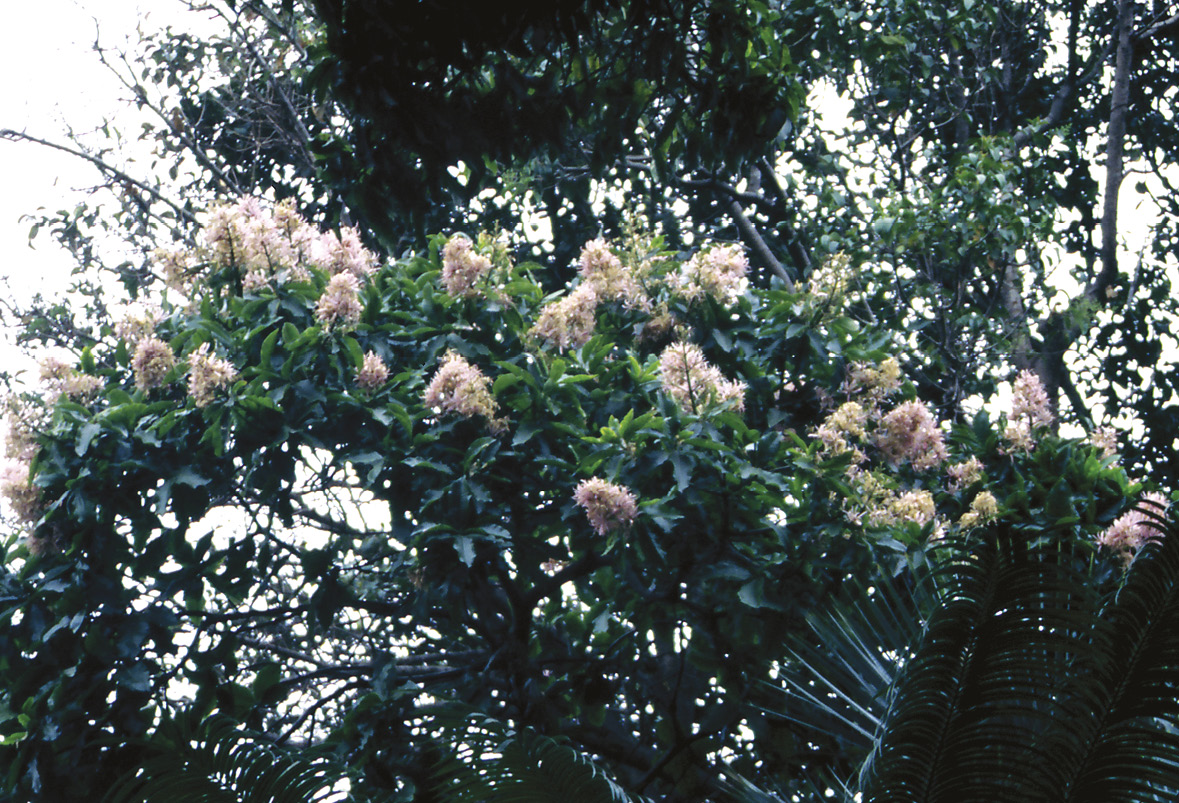
29


In the Gardens
Peruvian Pepper Tree
Schinus molle
Bloom time
From October to Febru-ary; fruit bearing from May onwards.
Characteristics
The tree grows up to 8 m (9 yd.) tall. With its pendulous twigs it reminds of a Weep-ing Willow. If you crumble the pinnate, likewise pen-dulous leaves they smell intensively of pepper. Green berries that become pink at maturity develop from the whitish, inconspicuous flow-ers organized in panicles.
Site:
On Madeira you will mainly find Peru-vian Pepper Trees as ornamental plants at the southern coast, up to an altitude of 400 m (440 yd.). They are most frequently culti-vated in the parks and gardens of Funchal; e.g. there are various specimens to be found in the Parque Santa Catarina (198).
Interesting to know:
The Peruvian Pepper Tree is not only native to Peru - as implies the denomination - but to all tropical sites in Latin America from Argentina to Mexico. It is not related to the Black Pepper Plant (Piper nigrum), which provides authentic pep-per. The fruits also taste hot but somewhat bit-ter and resinous; in former times they were used to thin down the expensive authentic pepper. The “pink berries” that are on the market today use to be fruits from the Brazilian Pepper Tree (Schinus terebinthifolius). They are toxic in larg-er quantities and should thus be used thriftily.
30
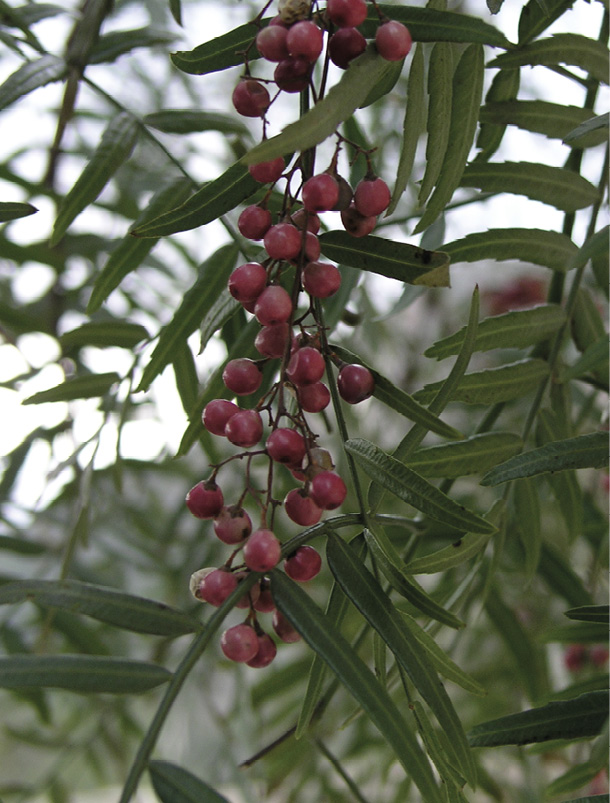
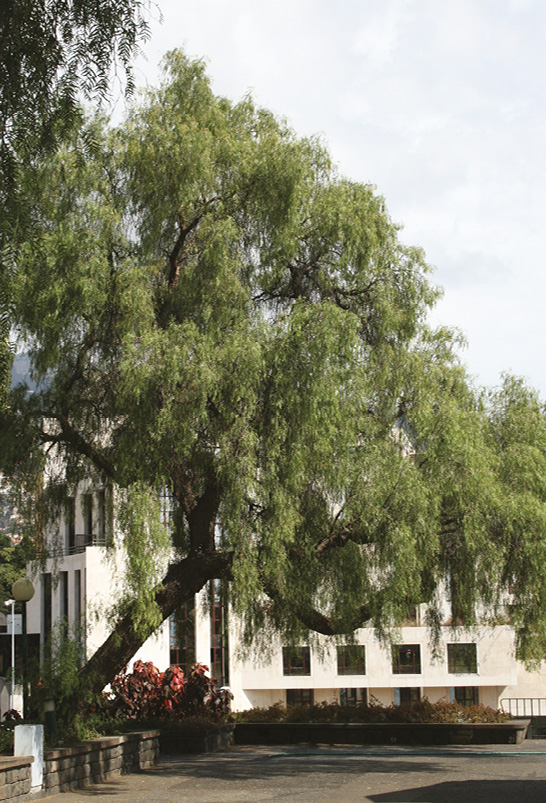


In the Gardens
Tricoloured Frangipani, Tricoloured Temple Tree
Plumeria tricolor
Bloom time
From June to October; single blossoms all year round.
Characteristics
The tree grows up to 6 m (6,5 yd.) tall; first branches emerge shortly above the ground. The gnarled branches contain a milky sap and form a broad crown. The dark green leaves are large and longish. They are shed up during bloom-ing time and leave scars. The flowers are coloured cream-pink or cream-orange.
Site:
The Tricoloured Frangipani grows in parks and gardens in south coast areas up to an altitude of 300 m (330 yd.). In Funchal, beautiful specimens are to be found in the Parque Santa Catarina (198)and in the Jardim Municipal (198).
Interesting to know:
The Tricoloured Frangipani is indigenous to Mexico and the northern part of South Amer-ica. The wild form has white blossoms with a yellow base. Today the cultivars are mostly grown in tropical Asia. As a symbol of eternal life they are commonly planted in temple areas and on graveyards together with the Singapore Frangipani (Plumeria obtusa). Frangipani was the name of the Italian producer of a popu-lar perfume in the 12th century. It is said that when Europeans discovered the tree centuries later in America, the strong fragrance of the blossoms reminded them of this perfume. On Madeira you can also find the Red Frangipani.
31
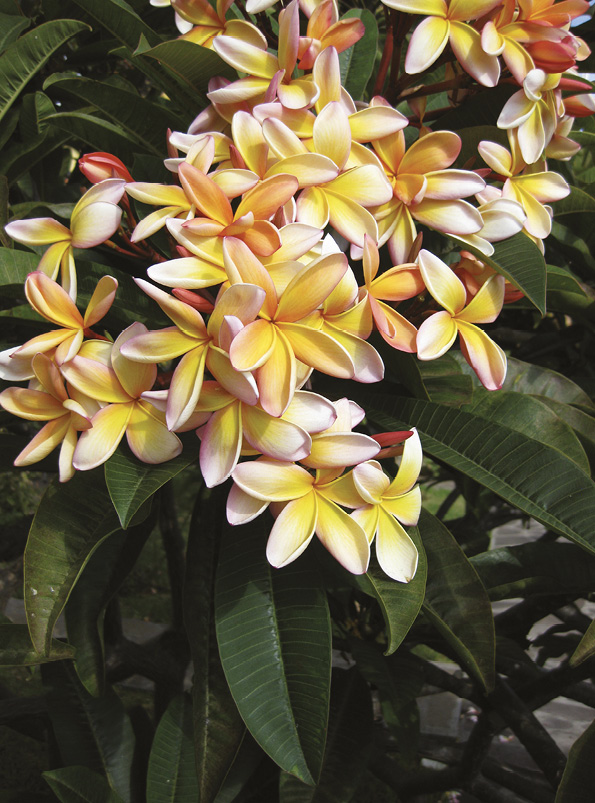
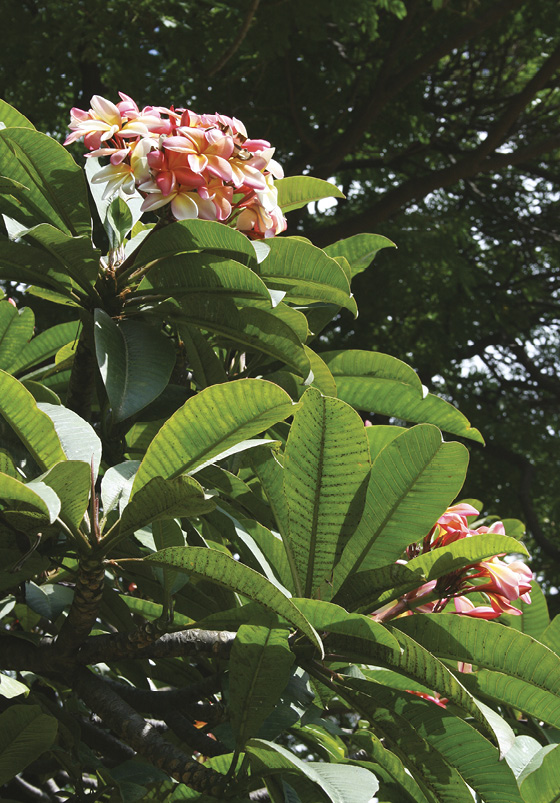


In the Gardens
Purple Orchid Tree,
Camel’s Foot Tree
Bauhinia variegata
Bloom time
From January to April.
Characteristics
On Madeira the tree will not grow more than 4 m (4,5 yd.) tall. It has long, thick twigs and silver leaves that hang on short stalks. They are clearly notched at the tip and give the impression of two leaves having grown into one anoth-er. The single blossoms are 10 cm (4‘‘) broad and colour-ed pink or narrow purple.
Site:
The Purple Orchid Tree is a rare ornamental plant in the gardens and parks of the south. Next to the entrance to the carport of the casino of Funchal you will find a beautiful specimen. Oth-ers are to be seen in the Parque Santa Catarina (198)and in the Botanical Garden (190).
Interesting to know:
The tree is native to regions from India to South China, mostly to the inclinations of the Him-alayas. Today it is cultivated in many tropical and subtropical countries. Many of the other 300 Bauhinia species are also growing in vari-ous gardens worldwide. They are called orchid trees because of their blossoms. One of each five-crown petals is lip-like enlarged; thus they remind of the orchids belonging to the genus Cattleya. Anyway the orchid trees are not related to the orchids. The botanical name is derived from the researchers Johann and Caspar Bauhin (1541-1613 and 1560-1624).
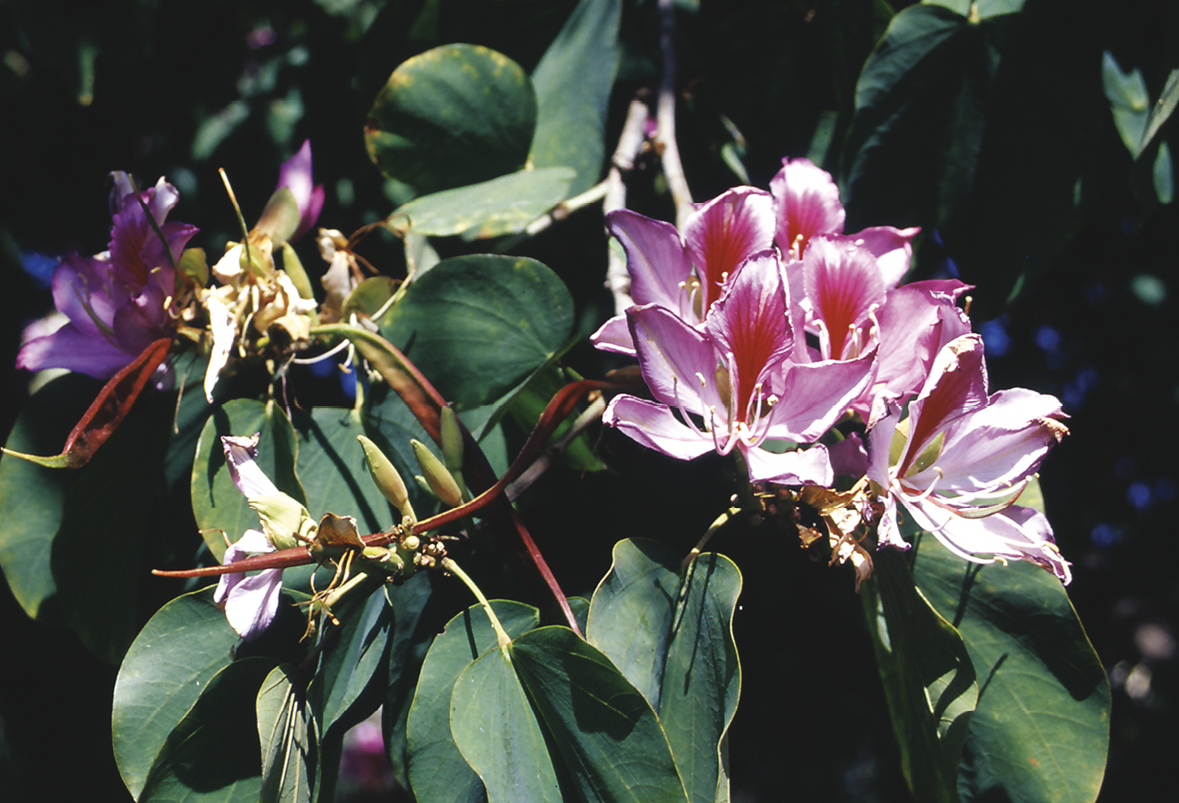
32


In the Gardens
Yellow Angel’s Trumpet,
White Angel’s Trumpet
Brugmansia candida
Bloom time
All year round.
Characteristics
The up to 4 m (4,4 yd.) tall shrub has numerous, trum-pet-like blooms that are up to 20 cm (8‘‘) long. The five petals grow together and form the trumpet’s “neck”. At the verge of the broad opening they run into pointed ends. Young leaves are covered with hairs and slightly serrated, later they become smooth and entire.
Site:
On Madeira you find Angel’s Trumpets in many gardens and parks. They grow in coastal areas and in the south of the Island even up to an alti-tude of 500 m (550 yd.). Beautiful specimens you will find in the park of the Quinta Vigia (198), Funchal, and in the Palheiro Gardens (191).
Interesting to know:
In former days the plants of the genus Brug-mansia were assigned to the genus Datura (thorn apple). Today only herbal plants with spiny fruits are classified as Daturas. The Angel’s Trumpet is an hybrid of various South American wild species. You may also encounter the Gold-en Angel’s Trumpet (Brugmansia aurea), a simi-lar plant native to the northern Andes that is as well cultivated on Madeira as a garden plant. All parts of Brugmansia plants contain toxic alka-loids. Golden Angel’s Trumpet is said to be espe-cially poisonous. Indian medicine men prepare an intoxicating drink from its leaves and seeds.
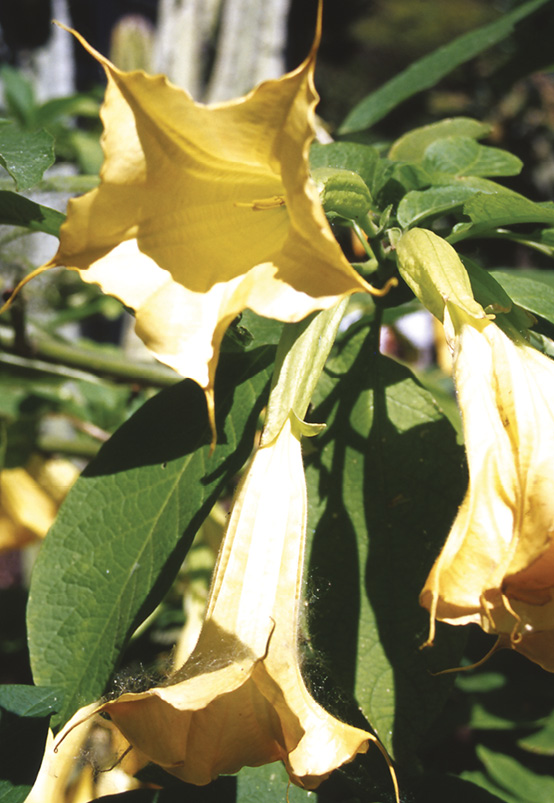

33


In the Gardens
Japanese Camellia
Camellia japonica
Bloom time
From January to March.
Characteristics
The Japanese Camellia can reach up to 3 m (10‘) tall and ranges between shrubs and trees. The leaves are egg-shaped, dark green, leathery and glossy. The flowers that remind of roses develop from numerous buds; they only barely scent. There are pink, red and white kinds of blossoms.
Site:
The Japanese Camellia grows at all sites that are the natural habitat of the warmth prefer-ring part of the laurel forest. In correspond-ing regions you will find it in parks and gar-dens. A Camellia avenue is guiding towards the Palheiro Gardens (191). Especially beautiful Camellias are also to be found in the park of Queimadas, in Ribeiro Frio (197) and in the Quinta do Santo da Serra (196).
Interesting to know:
Camellias are native to East Asia and were named in the 18th century by the popular natural scien-tist Linné. He derived their name from the Moravi-an abbot Camellius who dedicated himself to nat-ural historic studies on the Philippines. Only in the early 19th century the first Camellias came from China and Japan to Italy. Cultivation was contin-ued in Milan and Florence. The wild form does have simple pink flowers. Today there are cultivars with double flowers and in various colours.
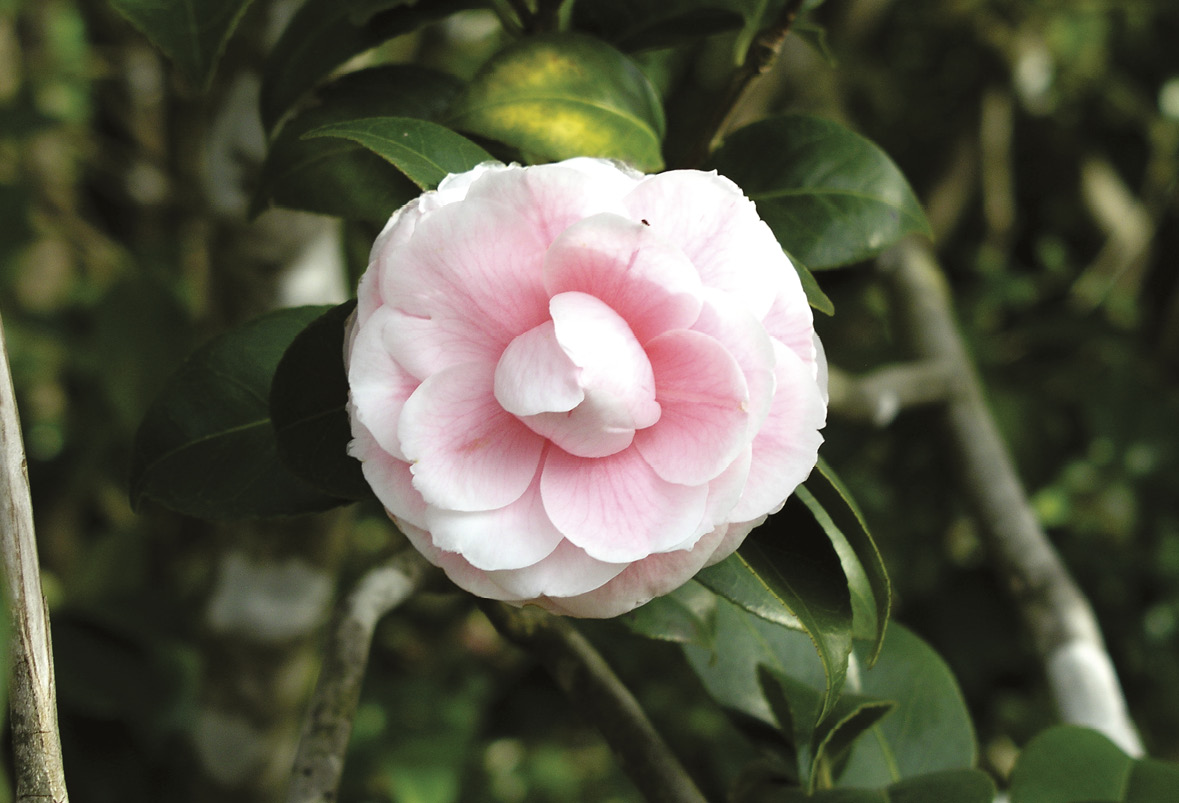
34


In the Gardens
Common Oleander, Rose Bay
Nerium oleander
Bloom time
From May to August.
Characteristics
The shrub grows up to 3 m (10‘) tall. The twigs grow upright; the leaves are long, narrow and leathery. Its numerous blooms are mostly white or pink and resemble little wheels for its five pet-als that are curved clockwise. You may also find strong red flowering, decorative cultivars that use to be stuffed.
Site:
The Common Oleander grows mainly in the south up to an altitude of about 400 m (440 yd.). It prefers a dry and sunny climate and is culti-vated at roadsides or on traffic islands. More-over you find it decorating parks and gardens.
Interesting to know:
In its natural habitat, the Mediterranean re-gions, the Common Oleander grows frequently at courses of rivers that dry out seasonally. Al-ready in the ancient world Common Oleander was recognized as an ornamental plant. Depic-tions of the shrub are to be found on Cretan murals dating from the 14th century BC and in Pompeii. Cross-breedings with the fragrant Sweet-scented Oleander (Nerium odorum) from India produced intensively smelling spe-cies. The Common Oleander plant contains substances that could cause cardiac arrest. In South France the pulverized bark is used as rat poison. Even wood and leaves are poisonous.
35
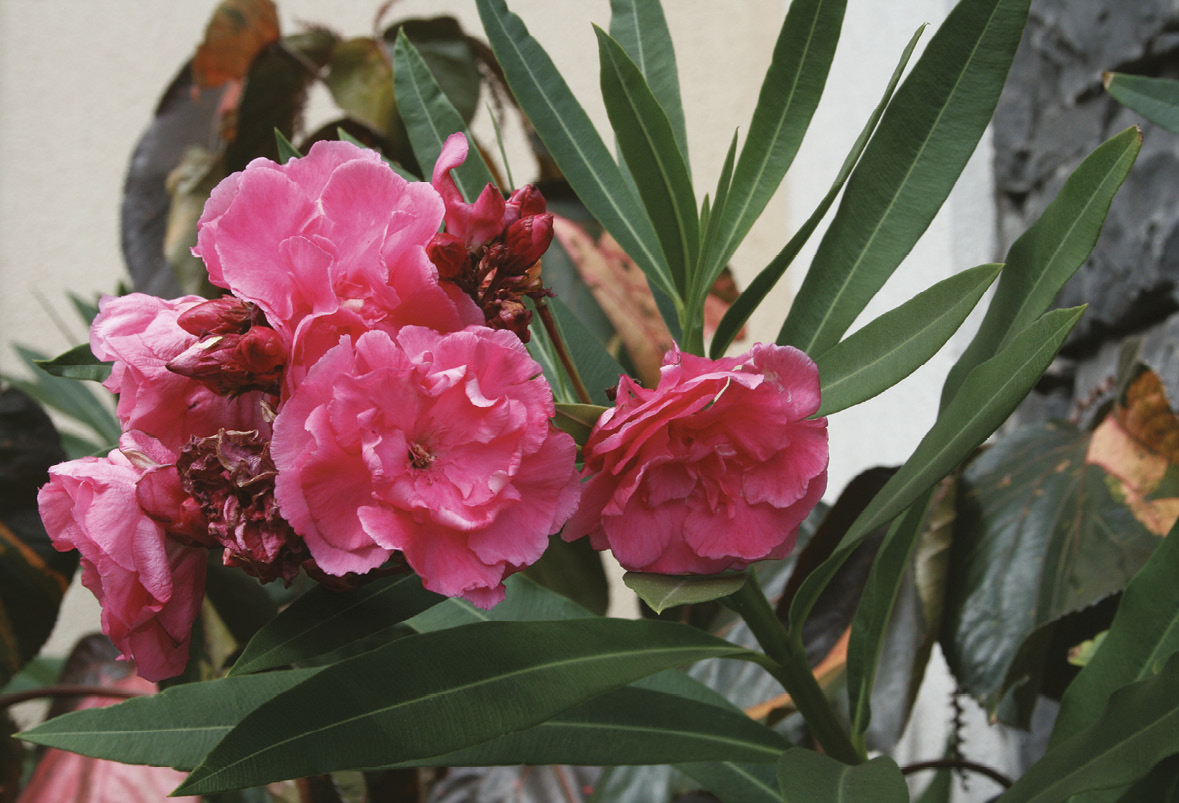


In the Gardens
Chinese Hibiscus, Rose of China
Hibiscus rosa sinensis
Bloom time
All year round.
Characteristics
The shrub is 1-3 m (3,3-10‘) tall and develops a dense net of branches. The leaves are heart-shaped and serrated. The blossoms consist of five petals that form a funnel with up to 10 cm (4‘‘) width. Colours range from red and pink trough white to orange and yellow. The pistil pro-trudes far out of the bloom.
Site:
On Madeira you will find this shrub in parks and gardens up to an altitude of 400 m (440 yd.). For its dense growth it is often used for cultivating hedges. The hardy Rose of Sha-ron (Hibiscus syriacus) is a rare relative with smaller, pink flowers and very upright twigs.
Interesting to know:
The Chinese Hibiscus is one of the most popu-lar ornamental shrubs. In its native habitat in South East Asia it has already been cultivated for a long time. Female Asians used to colour their hair and eyebrows with the sap. The wild species has shining red blossoms, cultivars may have flowers in varying colours, stuffed or enlarged blossoms and speckled leaves. The blossoms are extremely short living but the abundant development of buds makes up for the fact that each flower will only last one day.
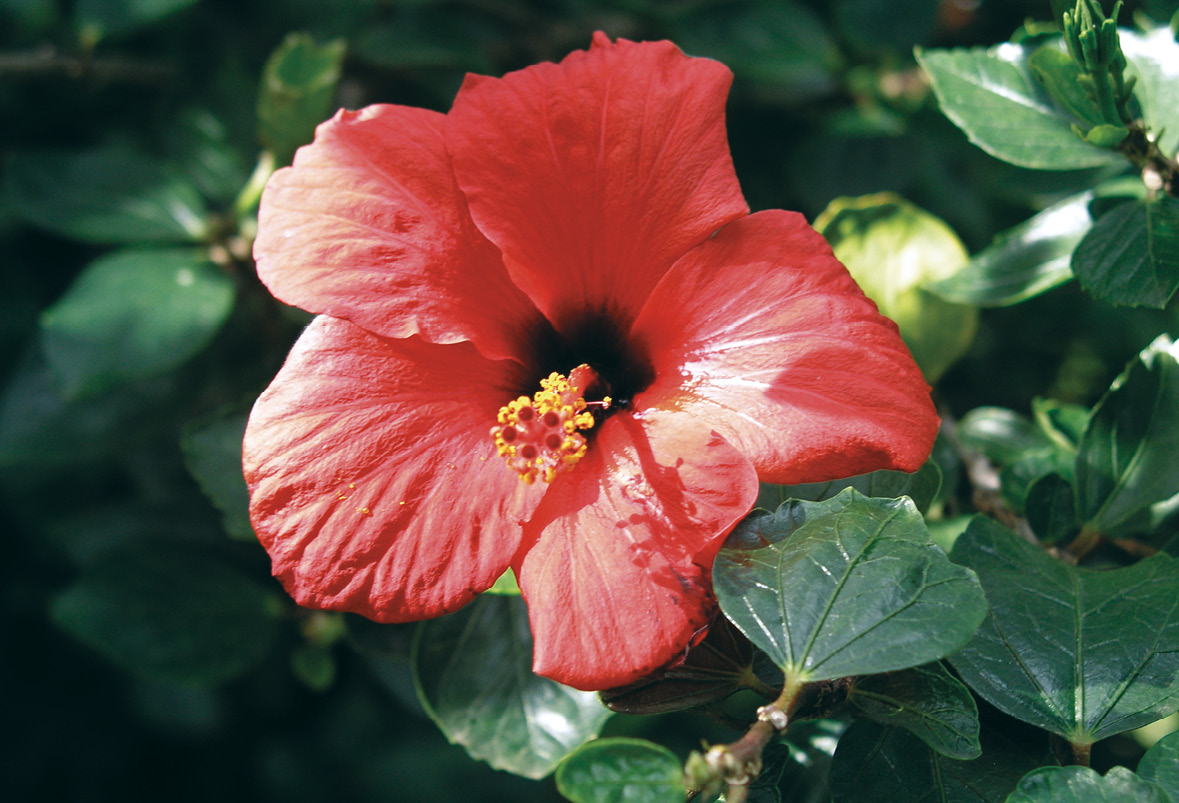
36


In the Gardens
Brazilian Spider Flower
Tibouchina urvilleana
Bloom time
All year round.
Characteristics
The shrub grows up to 3 m (10‘) tall and has oval, tapered, velvety leaves. Each leave is conspicuously sub-divided by several longitu-dinal veins from which are branching smaller, vertical leaf nerves. The flowers con-sist of five bluish-purple pet-als. The stamens are thread-shaped and curved like horns.
Site:
Mainly situated in the north of the island, the Brazilian Spider Flower can be found in gardens and parks at an altitude of 200-700 m (220-765 yd.). It prefers a more shady and humid hab-itat. You may for example find various speci-mens in the Quinta do Santo da Serra (196).
Interesting to know:
The Brazilian Spider Flower is native to Brazil and the adjoining countries. Today it is a popu-lar ornamental plant in all tropical and subtrop-ical regions for its showy blossoms. The genus’ name derives from a denomination in a native Guiana language. It was introduced in litera-ture by the French natural scientist Aublet who visited Guiana in 1762. The genus Tibouchina consists of about 250 species, all of them con-taining plentiful aluminium. The Indian medi-cine appreciates the plant for its styptic effects.
37
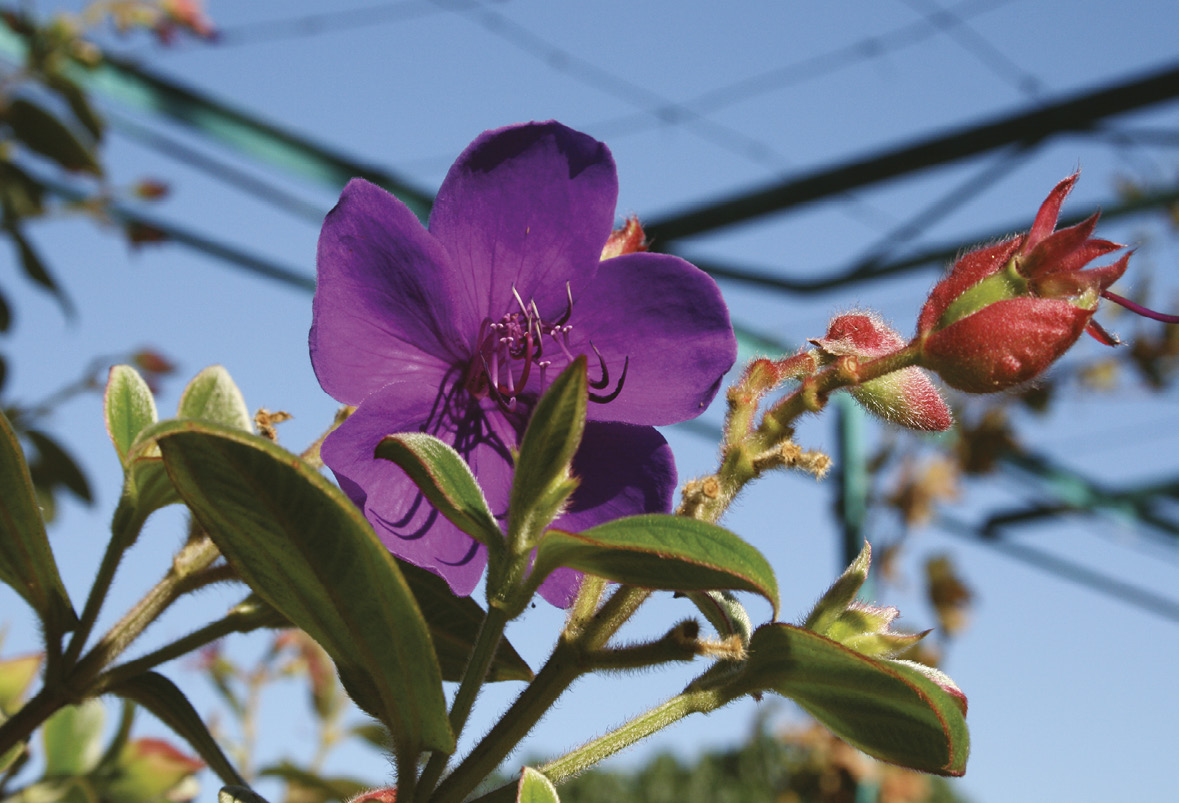


In the Gardens
Popcorn Bush,
Peanut Butter Cassia
Senna didymobotrya
Bloom time
All year round, mainly in spring and summer.
Characteristics
The decorative shrub grows 1,5-3 m (5-13’) tall and has upright twigs at which extremes you find sever-al racemes of golden yellow blossoms at erect stalks. The brown buds open from bot-tom to top; a part of the bud remains closed for a long time. The large, evergreen leaves are monopinnate.
Site:
The Popcorn Bush is often cultivated on Madeira; most easily you will find it in the south of the island up to an altitude of 450 m (490 yd.). You may also frequently discov-er the plant not only in the city of Funchal, but also in Caniço and in Caniço de Baixo.
Interesting to know:
The Popcorn Bush is native to tropical East Af-rica. It is often mixed up with the Candle Bush. Anyway, the latter has yellow buds; thus the en-tire inflorescence seems to be made of wax. This plant is not cultivated on Madeira. A noticeable characteristic of the Popcorn Bush is the slight-ly unpleasant smell that is exuded by the leaves or by buds when crumbling them. This smell re-minds of rancid peanut butter or old popcorn.
38
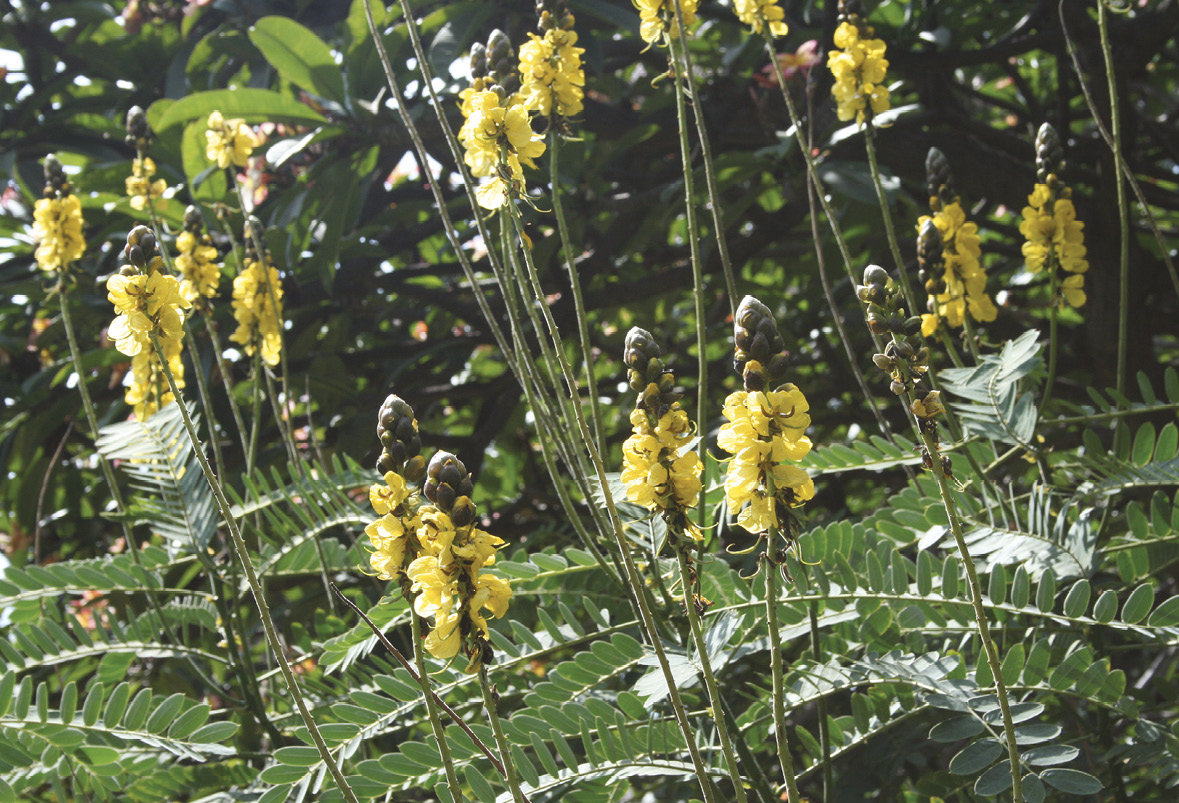


In the Gardens
Lobster Claw, Parrot’s Beak
Clianthus puniceus
Bloom time
From March to May.
Characteristics
The shrub with a height up to 2 m (6,6‘) is easily mixed up with smaller specimens of the related Cock’s Comb Coral Tree (cf. p. 25). Anyway, Lob-ster Claw’s clusters of orange flowers hang downwards. Single blossoms remind of parrots’ beaks. The leaves are finely pinnate, the twigs are conspicuously curved.
Site:
On Madeira, Lobster Claw prefers altitudes of 350-700 m (385-765 yd.); anyway it can also be found at coastal levels. It is quite frequently cultivated in gardens, parks and at roadsides - among others mainly in Funchal and Caniço.
Interesting to know:
Lobster Claw is native to New Zealand. For overgrazing of its habitats it is nearly extinct there and ranges among the most threatened plant species of the world. Fortunately it can easily be cultivated. Especially in England it is very popular as an ornamental plant for its dense inflorescence. It tolerates light frost and can thus be grown outdoors. Moreover it is to be found in greenhouses of botanical gar-dens or in many private vineyards in Central Europe. As a climbing plant it is popular for being grown in hanging baskets or at trellis-es. Apart from specimens with orange flow-ers you can find cultivars in pink and white.
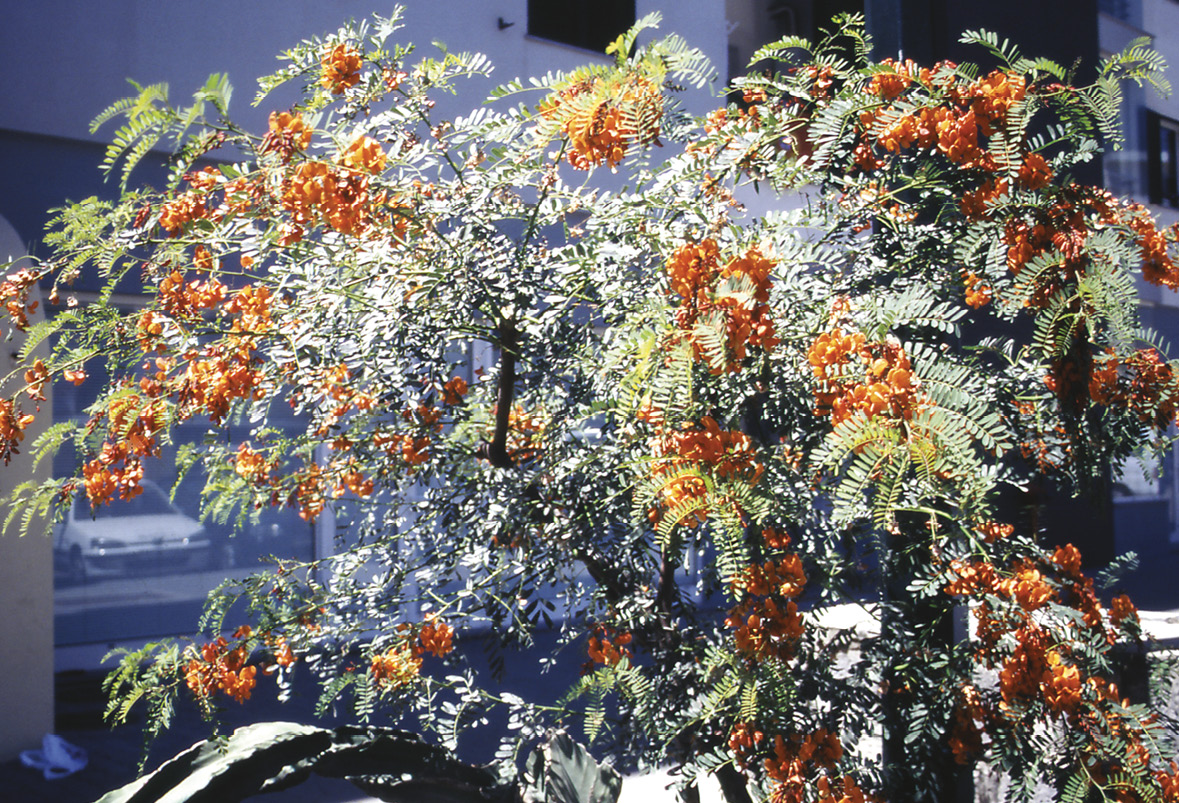
39


In the Gardens
Stiff Bottlebrush
Callistemon rigidus
Bloom time
From April to June.
Characteristics
The evergreen shrub grows 1-2 m (3,3-6,6‘) tall. Its leathery leaves emerge from the twigs like beaters. They remind of a conifer’s needles and scent aromatically when crumbling them. Stamens stick out from every single blossom; thus the shining red flower clus-ters resemble bottlebrushes.
Site:
On Madeira the Stiff Bottlebrush grows in coast-al areas. In the south it reaches up to an altitude of 450 m (490 yd.). Single specimens are deco-rating various parks and gardens. Among others you can find it in the Parque Santa Catarina (198) or close to the volcanic cave in São Vicente.
Interesting to know:
The Stiff Bottlebrush is native to Southeast Australia and adapted to frequent bush fires. The leaves contain ethereal oils and catch fire that fast that the oxygen is removed from the flame; the twigs hardly do not suffer any damage. The seeds stay with the plant for sev-eral years in cone-like groups. They only open and sprout after having been exposed to fire. As they grow among the ashes of a burnt off vegetation they scarcely have any rivals. The similar Weeping Bottlebrush is also cultivat-ed on Madeira. Its leaves are softer; the twigs hang down like those of a Weeping Willow.
40
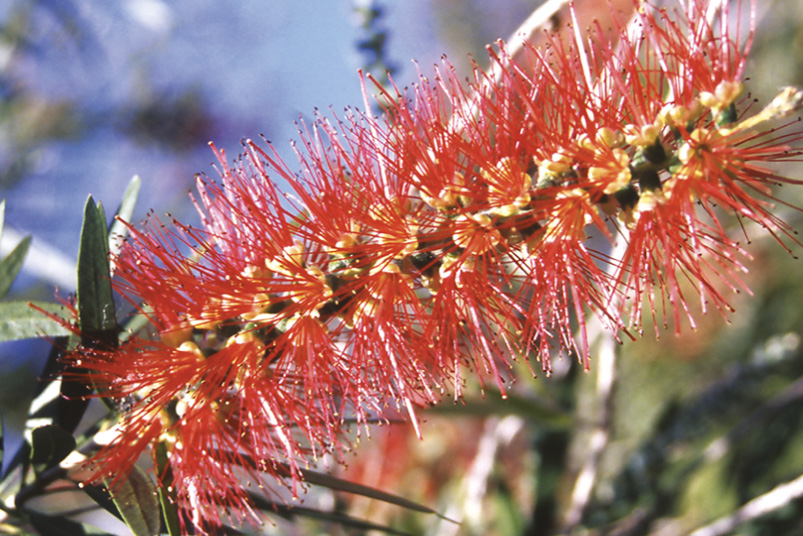
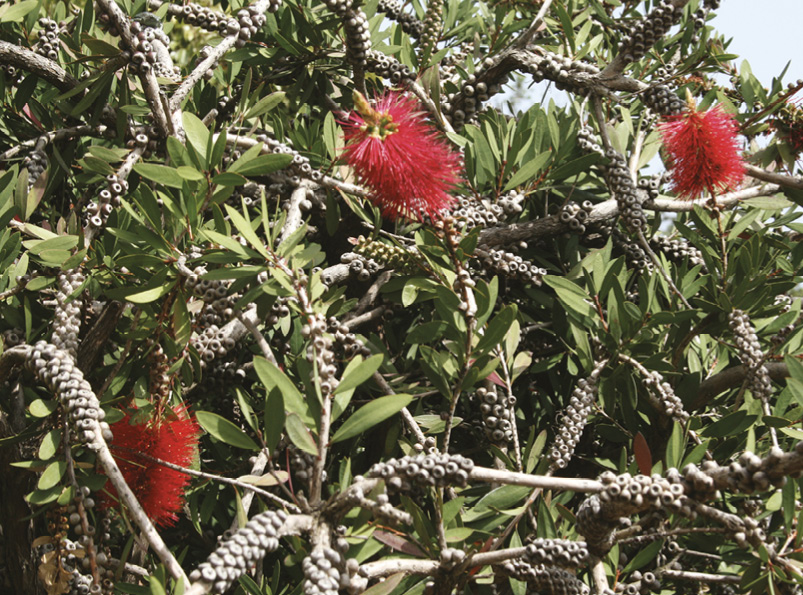


In the Gardens
King Protea, Cape Artichoke Flower
Protea cynaroides
Bloom time:
From April to June.
Characteristics:
The plant grows 1-1,5 m (3,3 – 5’) tall. The leathery, spatula-shaped leaves are slightly crinkled and shine silvery. The calyces resemble artichokes or thistles. The outer bracts are coloured from violet to pink, the colour of the inner, tubular blooms ranges from a pale violet through green to silver.
Site:
In the Palheiro Gardens you will find King Proteas growing in two groups. Further protea species with blooms of different colours can be explored as well. Single specimens are to be found in the garden of the Quinta of Prazeres or close to the Quinta do Furão. At some places close to Camacha at an altitude of 400-700 m (440-765 yd.) or in the region above Calheta, proteas are cultivated for commercial purposes.
Interesting to know:
In the 20th century Mildred Blandy direct-ed Blandy’s Garden (currently known as the Palheiro Gardens) for five decades. She introduced Proteas to Madeira. She had raised in South Africa and thus felt a spe-cial affection for the flora of her motherland. After already being very fashionable in the 19th century, Proteas were rediscovered as cut flowers in the last years. Having been dried they stay attractive for several months.
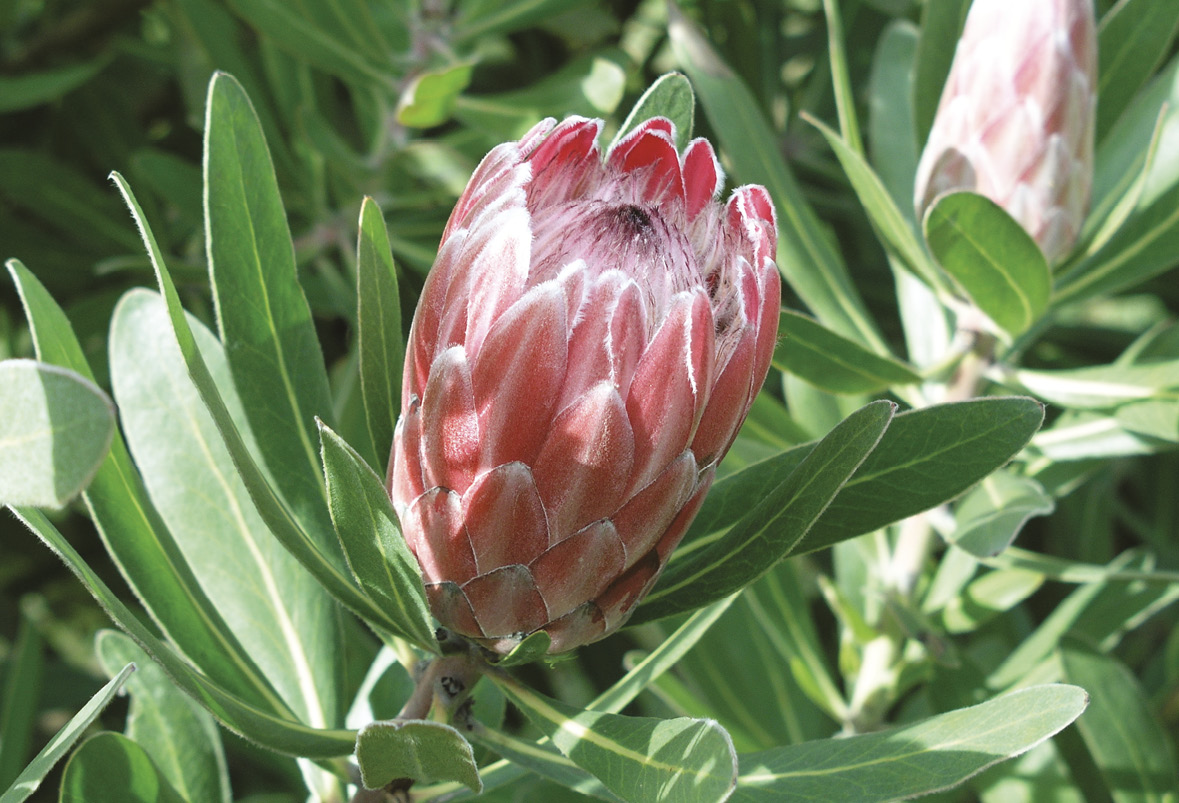
41


In the Gardens
Lesser Bougainvillea
Bougainvillea glabra
Bloom time
All year round, mainly in early summer.
Characteristics
The thorny climbing plant grows up to 25 m (28 yd.) tall on (building) walls. The leaves don’t carry hairs. The actual blooms are yellowish and very small. Shining, purple red, oval-tapered bracts surround each three of them. There are cultivars with varying colours.



